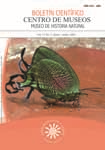Autores/as
Resumen
Este estudio tiene como objetivo analizar la composición, diversidad y abundancia de arañas orbitelares en tres hábitats aledaños a la Laguna Negra, Santuario de Flora y Fauna Galeras, correspondientes a Bosque, Arbustal y Pastizal, identificándose en cada uno de ellos los microhábitats y estratos vegetales ocupados por las arañas orbitelares para la ubicación de sus telas y refugios. La araneofauna orbitelar fue muestreada manualmente mediante la técnica “revelado de telas”, que consiste en espolvorear la vegetación con harina para visualizar los hilos; y estuvo conformada por tres familias: Araneidae, Tetragnathidae y Uloboridae, distribuidas en 6 géneros, siendo Chrysometa el dominante. Se detectó además que los hábitats de Arbustal y Pastizal comparten el 77% del total de las especies registradas, indicando más de una comunidad de arañas orbitelares en más de un tipo fisionómico de la vegetación. En cuanto a los estratos, se encontró que el bajo y medio poseen el mayor número de individuos, esto al parecer por la amplia disponibilidad de recursos físicos que les brinda la vegetación para la construcción de las telas. Concluyendo, finalmente, que los principales factores que pueden influir en la distribución y diversidad de la araneofauna orbitelar estudiada, son la diversidad y abundancia de soportes estructurales en la vegetación y la disponibilidad de alimento.
Palabras clave
Citas
CEPEDA, J. & FLÓREZ, E., 2007. Arañas tejedoras: uso de diferentes microhábitats en un bosque andino de Colombia. Revista Ibérica de Aracnología, 14: 39-48.
CODDINGTON, J. & LEVI, H., 1991. Systematics and Evolution of spiders (Araneae). Annual Review of Ecology and Systematics, 22: 565-592.
COLEBOURNE, P.H., 1974. The influence of habitat structure on the distribution of Araneus diadematus. Journal of Animal Ecology, 43: 401-409.
COLWELL, R., 2005. Estimates: Statistical estimation of species richness and shared species from samples. Uso de la guía y aplicaciones (en) http://viceroy.eeb.uconn.edu/estimates.
COMSTOCK, J., 1948. The spider book. Vail Ballou Press.
EBERHARD, W., 1976. Photography of orb webs in the field. Bulletin of the British Arachnological Society, 3 (7): 200-204.
FLÓREZ, E., 1998. Estructura de comunidades de arañas (Araneae) en el Departamento del Valle, suroccidente de Colombia. Caldasia., 20 (2): 173-192.
__________., 1999. Estudio de comunidades de arañas (Araneae) del Parque Nacional Farallones de Cali, Colombia. Cespedesia, 23 (73-74): 99-113.
FLÓREZ, E. & SÁNCHEZ, H., 1995. La Diversidad de los Arácnidos en Colombia. Aproximación inicial: 327-372 (en) RANGEL, O. Colombia Diversidad Biótica I. Bogotá: Guadalupe Ltda.
FOELIX, R., 1996. Biology of spiders. Oxford University Press.
GREENSTONE, M.H., 1999. Spider predation: how and why we study it. The Journal of Arachnology, 27: 227-235.
GUNNARSON, B., 1990. Vegetation structure and the abundance and size distribution of spruce-living spiders. Journal of Animal Ecology, 59: 743-752.
HAMMER, O., HARPER, D.A.T. & RYAN, P.D., 2001. Past: Paleontological statistics software package for education and data analysis. Paleontología electrónica, 4 (1): 9.
INSTITUTO DE HIDROLOGÍA, METEREOLOGÍA Y ESTUDIOS AMBIENTALES DE COLOMBIA (IDEAM)., 2004. Regional Nariño-Cauca. Estación Obonuco, Pasto-Nariño.
JANETOS, A., 1986. Web- site selection: are we asking the right questions?: 9-22 (en) SHEAR, W., Spiders webs, behavior, and evolution. Stanford University Press, California.
LEVI, H., 1966. The neotropical orb-weaver genera Chrysometa and Homalometa (Araneae: Tetragnathidae). Bulletin of Museum of Comparative Zoology, 151 (3): 91-211.
__________., 1976. The orb-weaver genera Verrucosa, Acanthepeira, Wagneriana, Acacesia, Wixia, Scoloderus and Alpaida North of Mexico (Araneae: Araneidae). Bulletin of Museum of Comparative Zoology, 147 (8): 351-391.
__________., 2002. Keys to the genera of Araneid orbweavers (Araneae, Araneidae) of the Americas. The Journal of Arachnology, 30: 527-562.
MADRIGAL, A., 2001. Fundamentos de control biológico de plagas. Centro de Publicaciones Universidad Nacional.
MAGURRAN, A., 1989. Ecological diversity and its measurement. Ediciones Vedrá.
MORENO, C., 2001. Métodos para medir la biodiversidad. Editorial Manuales y Tesis (M&T) SEA. Vol. I.
MARSHALL, S. & RYPSTRA, A., 1999. Spider competition in structurally simple ecosystems. The journal of Arachnology, 27: 343- 350.
NYFFELER, M., 1999. Prey selection of spiders in the field. The Journal of Arachnology, 27: 317-324.
OPELL, B.D., 1979. A key to neotropical genera of Uloboridae. Bulletin of Museum of Comparative Zoology, 148 (10): 443-549.
RIECHERT, S. & CADY, A., 1983. Patterns of resource use and tests for competitive release in a spider community. Ecology, 64 (4): 899-913.
RIECHERT, S. & GILLESPIE, R., 1986. Habitat choice and utilization in web-building spiders: 23-48 (en) SHEAR, W. Spiders webs, behavior, and evolution. Stanford University press, California.
ROHLF, F. J., 2000. Numerical taxonomy and multivariate analysis system. Exeter publishing Ltd.
TURNBULL, A., 1973. Ecology of the true spiders (Araneomorphae). Annual Review of Entomology, 18: 305-347.

 PDF
PDF
 FLIP
FLIP



















